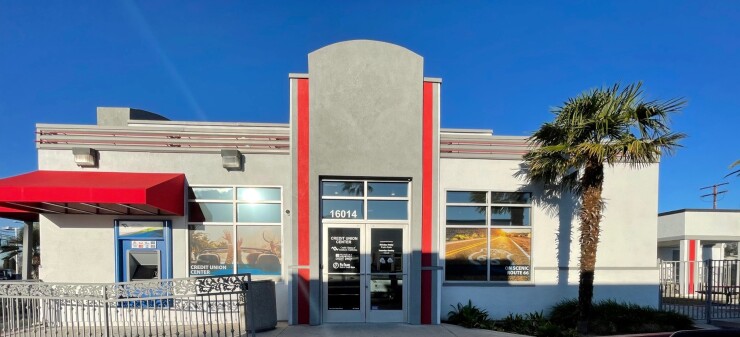A trio of California credit unions have embarked on an unusual branching strategy, with all three institutions sharing one facility.
The Credit Union Center, in Fontana, Calif., brings together Anaheim-based Credit Union of Southern California, Gardena-based Pacific Transportation Federal Credit Union, and Printing Industries CU of Riverside, Calif. Branch staff can serve members of any of the three credit unions, and all three evenly split the costs of shared services, said Aaron Young, vice president of branch operations and retail banking for CU SoCal.
Each credit union remains independent, with no discussion of mergers, he added.

The arrangement is unusual because while many credit unions operate as part of shared-branching networks – in which members of participating institutions can do business at any branch in that network – and others have
While members can be served by employees from any one of the three credit unions, signage and logos inside serve as visual markers to help visitors navigate where to go for service. In the event of new memberships, said Young, team members from the relevant credit union are on hand for onboarding.
At over $2 billion of assets, CU SoCal is substantially larger than the other two institutions, whose assets together total about $100 million. This arrangement allows those credit unions to expand access for their members without the same outlay of funds normally required to expand a branch network.
All three are members of the CO-OP Shared Branch network, and Kathy Snider, a senior vice president at CO-OP Financial Services, said the shared-facility arrangement “presents a win-win for the members and the credit union,” since the format allows for operational efficiencies while boosting all three institutions’ market presence.
There may be a reason the concept hasn’t been widely adopted, though. Kirk Drake, founder, president and CEO of Ongoing Operations, which specializes in credit union IT operations, noted that shared facilities can require a higher up-front investment in order to properly leverage financial, technological and management tools needed to scale efficiencies – which can be particularly tricky for smaller institutions.
Dennis Holthaus, managing director of Skyway Capital Markets, said the concept could confuse some members and potentially result in longer transaction times. “This could lead to trust issues, where the member may feel that something may be wrong with their credit union" because it's "operating in the same building with another credit union,” he said.
A shared-branch model also means one credit union’s members will frequently be interacting with another institution’s staff, noted Sam Brownell, founder and CEO of the consultancy CUCollaborate. That means extra emphasis must be placed on a providing consistent level of service for all members who enter the facility.
Despite the industry’s focus on collaboration, Drake said, the potential for missteps keeps many credit unions from embarking on this sort of set up.
“Many leaders mistake collaboration and consensus,” he said. “To truly move this forward, there needs to be great trust between all of the parties and leaders need to really focus on building trust for months with small wins before tackling the big wins.”
Still, there are signs that shared branching arrangements of any sort are becoming less popular among credit unions. Some institutions have
“In the shared branch environment, a credit union lacks the ability to do any selling unless it’s their branch and their members, so the value of shared branches, we believe, will continue to decline,” said Bill Handel, general manager and chief economist at Raddon, a Fiserv company.
Shared branching is primarily built around transactional activities, which were migrating to self-service channels even before COVID-19 hit, Handel said.
“The pandemic has accelerated that trend,” he said. “When your member does their basic transactional activities on the phone, they have less need of the credit union’s branches, let alone a shared branch.”
As the coronavirus crisis recedes, branches are likely to continue their transformation into facilities centered more on sales and member service, which even less of an emphasis on transactions, Handel said.
For CU SoCal and the others, said Young, this facility is part of a “test-and-learn process,” and the hope is that it can serve as a model for a sustainable format that can be replicated in the future.




